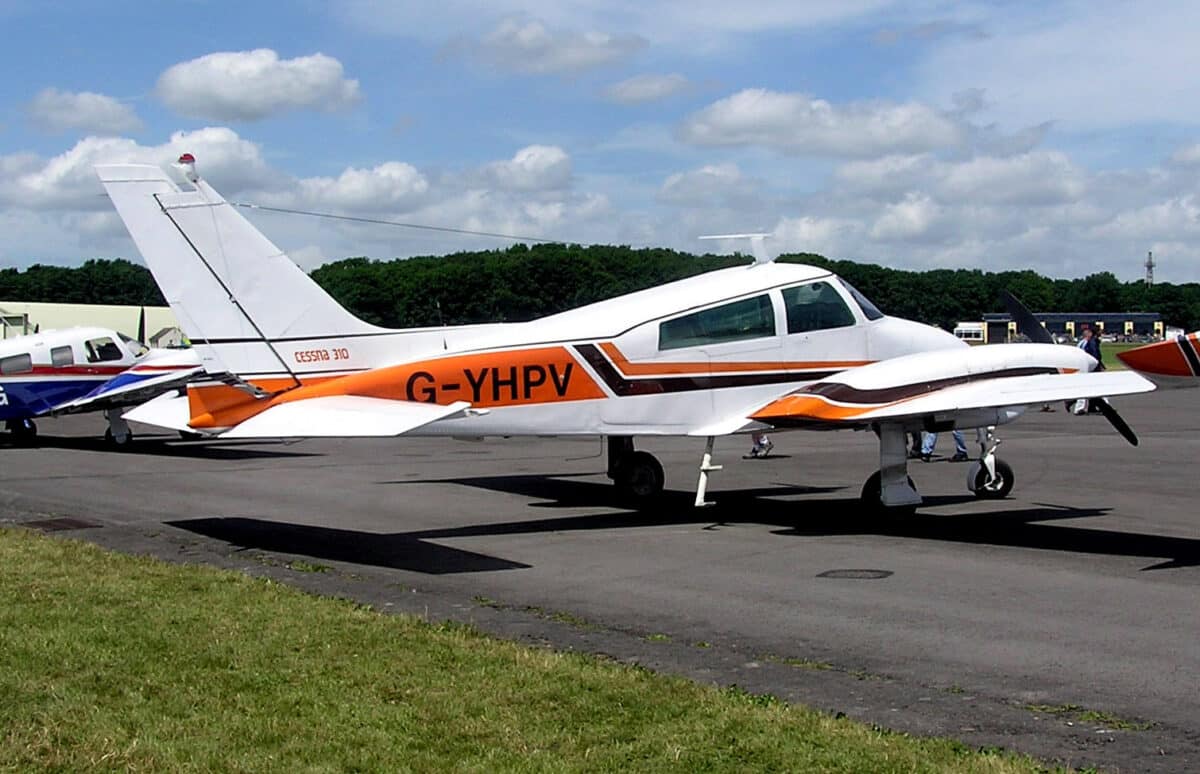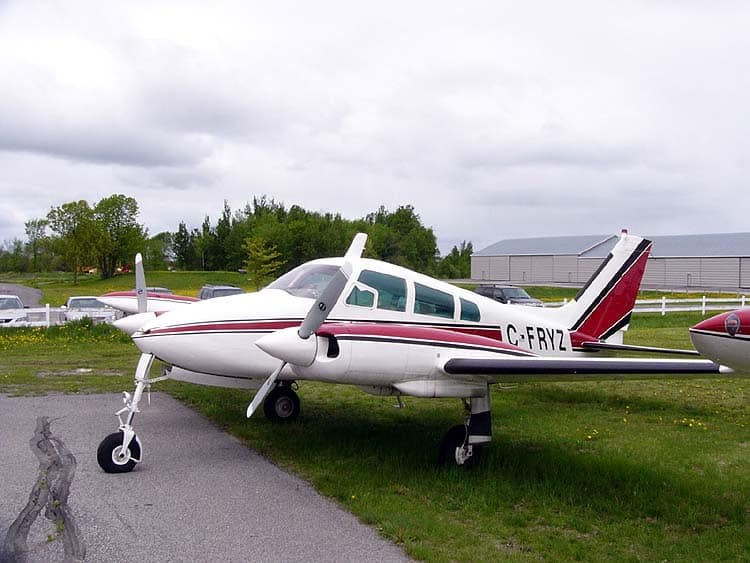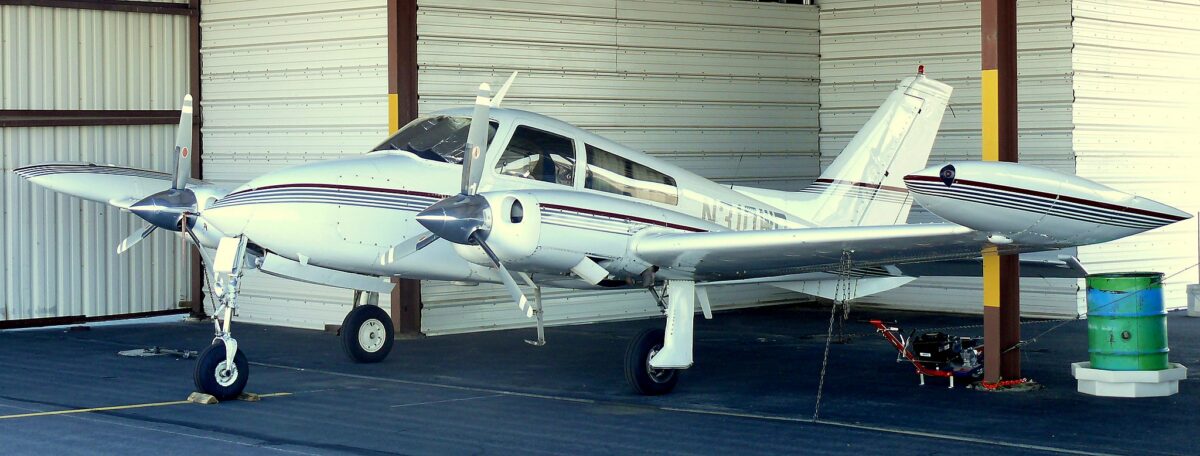The Cessna 310, with its distinctive twin-engine design and piston-powered propulsion, is a coveted aircraft among aviation enthusiasts. Dreaming of piloting one myself, I delved into the financial aspects of Cessna 310 ownership.
What’s does a Cessna 310 cost? A pre-owned Cessna 310, produced between 1958 and 1980, can set you back anywhere from $95,000 to $295,000. Annually, expect to shell out about $33,375 for insurance, maintenance, and hangar space, not accounting for depreciation. Flying this classic will cost you roughly $145 per hour, given you log 100 hours in the sky each year.
At PilotPassion, we are dedicated to bringing you the most engaging and relevant aviation content. As aviation enthusiasts and student private pilots, we strive to put ourselves in your shoes to deliver accurate and useful information regarding the costs of owning and operating a Cessna 310. Our goal is to save you time and energy while providing valuable insights into the world of aviation.

Table of Contents
Why the Cessna 310 is an Excellent Aircraft Choice
Newly certified private pilots often contemplate purchasing a Cessna 310 due to its moderate pricing, fuel efficiency, and user-friendly handling. This aircraft is an ideal option for those seeking a reliable, cost-effective, and enjoyable flying experience.
The Cessna 310, a versatile aircraft, can comfortably accommodate up to five passengers, including the pilot. In this article, we will discuss the total cost of ownership, financing options, and the factors to consider when purchasing a Cessna 310. Learn about the best personal aircraft options in our comprehensive guide.
Cost of Purchasing a Cessna 310
A good-condition, used Cessna 310 will set you back anywhere from $95,000 to $295,000 for models produced between 1958 and 1980. The Cessna 310, with its massive popularity, offers a wide range of options in terms of price, condition, age, and location.
First launched in 1954, this aircraft is easily accessible due to its abundant supply on the market. A Cessna 310 in decent condition can typically be found for around $95,000, but keep in mind that these planes tend to sell quickly once they become available.

Ownership Costs of a Cessna 310
Upon purchasing a Cessna 310, be prepared for ongoing expenses, including fixed and variable running costs. The total cost of ownership is estimated at $33,375 annually. This includes approximately $7,375 in fixed costs and around $26,000 in variable expenses (based on 100 annual flying hours).
Depreciation costs will also factor into the overall expenses, but estimating a precise value is challenging due to the numerous factors involved.
There are numerous fixed and variable expenses associated with airplane ownership that beginners may not be aware of. This holds true not only for Cessna 310s but for any aircraft. If you plan to purchase a new or used Cessna outright, you won’t need to worry about financing costs. If you require a loan to finance the acquisition, you must also factor in the interest repayment expenses.
What Are the Fixed Costs for Cessna 310 Ownership?
Fixed costs of aircraft ownership refer to the expenses you’ll incur regardless of whether the aircraft is flown or not.
For instance, if you buy a Cessna 310 and never use it, you’ll still need to cover fixed costs such as the one-time purchase price, hangar fees at the airport, insurance premiums, and annual inspection expenses. The total fixed costs will amount to approximately $7,375.
In addition to these expenses, you should also consider the depreciation of your aircraft’s value as an asset. Since the age, cost, resale value, and market conditions significantly vary, we cannot provide an exact figure for depreciation. However, it’s essential to be aware of this factor.
To ensure your aircraft passes the annual inspection, you’ll likely need to pay for any required maintenance. While some individuals categorize these maintenance costs as variable expenses, it’s more appropriate to classify them as fixed costs, since you’ll probably have to pay for them regardless of your aircraft’s usage.
Furthermore, there may be recurring subscription fees for services such as weather updates or ForeFlight that you should take into account as part of your fixed costs. Overall, it’s crucial to have a comprehensive understanding of all expenses related to aircraft ownership to make informed decisions and manage your budget effectively.
Hangar Costs for a Cessna 310
The cost of hangar space for a Cessna 310 can vary significantly based on factors such as location and the type of storage facility. In the United States, you can find hangar spaces for as low as $70 per month. However, opting for a higher-priced option might provide better facilities and enhanced security. Renting is not your only option; you may also have the opportunity to build or purchase your own hangar.
How much does insurance cost for a Cessna 310?
Insuring a Cessna 310 can be more affordable than you might expect. As with hangar costs, insurance rates can also vary greatly depending on factors such as location, flight frequency, aircraft value, and the type of coverage. Understanding these factors can help you find the most suitable insurance plan for your needs.
Insurance pricing for aircraft can vary significantly due to numerous factors. It is advisable to shop around, as you may find a lower rate. However, keep in mind that these lower rates often only provide liability-only coverage, which does not cover damage or loss to the aircraft itself but does cover damage or injury to third parties. The primary factor in determining the cost of insuring a Cessna 310 is the airplane’s valuation.
For a used Cessna 310, the approximate annual insurance cost is $2,600.
How much is an annual inspection for a Cessna 310?
The Federal Aviation Administration (FAA) mandates that aircraft undergo an annual inspection each year. The cost of this inspection for a Cessna 310 is roughly $2,750. It’s crucial to ensure that all parts are in working order and that oil and other fluids are topped up as required.
Considering these maintenance requirements, the fixed maintenance costs for a Cessna 310, including the annual inspection, could amount to approximately $7,375 per year.
What Are the Variable Costs for Cessna 310 Ownership?
The variable costs associated with owning a Cessna 310 typically include fuel, oil, unscheduled maintenance, and miscellaneous expenses such as landing fees, parking, and minor travel costs.
On average, these costs may amount to approximately $26,000 per year. The variable cost per flight hour is estimated at around $260. It’s essential to note that these figures are estimates, and your actual expenses may differ depending on various factors.
Generally, the longer you own the aircraft, the more likely it is for annual variable costs to increase. Unlike fixed costs, variable costs are only incurred when the plane is in operation.
Cessna 310 Fuel Costs
The Cessna 310 operates on avgas, with an estimated hourly fuel cost of around $145. Considering the current avgas price of approximately $5 per gallon, the Cessna 310 consumes 27.2 gallons on an hourly basis. It is advisable to compare avgas prices across various airports, as the charges may vary based on location and airport traffic.
Cessna 310 Oil
For individuals with technical expertise, handling oil changes personally can result in significant savings on labor costs.Paying for labor, oil, and filters can become quite costly if you don’t stay on top of your aircraft maintenance. For instance, the oil cost for a Cessna 310 usually amounts to around $5 per running hour.
Cessna 310 Engine Maintenance Costs
Approximately every 2,000 hours, the engine of a Cessna 310 requires an overhaul. The expenses associated with overhauling an airplane engine can escalate rapidly, depending on factors such as the engine’s condition, age, and accumulated wear and tear. Since safety is of utmost importance, an engine overhaul is an essential aspect of aircraft maintenance.
During the engine overhaul process, each component is thoroughly inspected, which includes pistons, bearings, cylinders, and other engine parts. By maintaining your aircraft’s engine, you ensure its reliability while avoiding unnecessary expenses.
Engine repairs and replacements are conducted as required. As an engine accumulates more flight hours, it will need to undergo comprehensive overhauls more frequently. We’ve discussed the fixed and variable costs; now, let’s explore how to make a Cessna 310 more affordable!

Financing Options for Purchasing a Cessna 310
There are various financing alternatives for acquiring a Cessna 310, as I know from friends who own this type of aircraft. One option is to secure a loan from a bank or financial institution.
Another possibility is leasing the aircraft, which allows you to use it for a predetermined period before returning it or even purchasing it at the end of the lease term. Lastly, consider buying a share in the aircraft with a trusted group of individuals.
This way, you can enjoy the benefits of ownership while sharing the costs and responsibilities. Whichever method you choose to purchase a Cessna 310, it’s crucial to thoroughly review all terms and conditions before signing any agreements. Understanding the complete terms and potential costs you might incur is essential.
Taking out a loan for a Cessna 310
One option for financing your Cessna 310 is to apply for a traditional loan from a bank or credit union. If you possess a high credit score and a strong financial history, this could be a smart decision. Alternatively, you can apply for a loan specifically designed for aircraft financing. These loans often provide more flexible terms and may be more accommodating to individuals with less-than-perfect credit.
Practical advice: Before selecting a lender, it’s always advisable to explore different options and compare rates and terms from multiple sources. Assess your financial situation carefully and ensure that you can comfortably manage the loan payments.
Leasing
For those who are not ready to commit to purchasing an aircraft outright, leasing a Cessna 310 can be an accessible and cost-effective financing option. Leasing involves agreeing to use the aircraft for a predetermined duration—usually several years—in return for a fixed monthly payment.
At the end of the lease, you have two choices: return the aircraft to the owner or potentially purchase it for a set amount. Wet leases (which include a pilot) and dry leases (providing only the plane) are available, with the dry lease option being the more popular choice.
It’s crucial to thoroughly research and compare lease options from different providers. As lease agreements often entail extensive paperwork, be sure to read the fine print carefully. Also, consider your ability to consistently make payments throughout the lease term, just as you would with loans.
Buying a Share in a Cessna 310
Purchasing a share in an aircraft allows you to co-own a portion of the plane and operate it jointly with other owners. This can be a practical alternative to outright ownership or long-term leasing for those who require access to an aircraft.
Shared Ownership: An Affordable Solution to Aircraft Ownership
Shared ownership, also known as fractional ownership, offers an affordable and flexible solution for individuals and organizations seeking the benefits of aircraft ownership without bearing the full cost.
By purchasing a share of an aircraft, owners can divide the initial investment and ongoing maintenance and operational expenses. This approach is commonly facilitated through local flying clubs, where many people first learn about the advantages of owning a fraction of an aircraft, such as a Cessna 310.
The appeal of fractional ownership lies in its cost-effectiveness and accessibility. It enables people or organizations to enjoy the benefits of aircraft ownership at a reasonable price by sharing the initial purchase cost and ongoing maintenance and operational expenses.
The amount of access and responsibility each owner has depends on the size of their respective shares, making this an attractive option for those who wish to fly for personal or professional reasons but cannot afford or justify owning a plane outright.
Fractional ownership is a viable alternative for companies that require regular access to an aircraft but do not want to assume full ownership responsibility. By opting for shared ownership, organizations can meet their aviation needs while minimizing financial and operational burdens.
Fractional ownership provides a practical, cost-effective solution for those looking to enjoy the advantages of aircraft ownership without the high costs and responsibilities typically associated with it. From personal enthusiasts to businesses, shared ownership opens up the world of aviation in a more accessible and affordable manner.
Cessna 310 Specifications
Manufacturer: Cessna Aircraft Company Model: Cessna 310 First flight: January 3, 1953 Production years: 1954-1980 Role: Light, twin-engine piston aircraft Seating capacity: Up to 6 passengers (including pilot) Engine: 2 x Continental O-470-B, -M, -N, or -U air-cooled, horizontally-opposed piston engines (depending on the specific 310 model) Horsepower: 240-310 hp (179-231 kW) per engine, depending on the specific 310 model Wingspan: 35 ft 8 in (10.87 m) Length: 27 ft (8.23 m) Height: 10 ft 6 in (3.20 m) Maximum speed: 230 mph (370 km/h) depending on the specific 310 model Cruise speed: 190-220 mph (306-354 km/h) depending on the specific 310 model Range: 1,000-1,200 miles (1,609-1,931 km) depending on the specific 310 model Service ceiling: 20,000 ft (6,096 m) depending on the specific 310 model Rate of climb: 1,700 ft/min (8.63 m/s) depending on the specific 310 model Wing loading: 23.7 lb/ft² (115.7 kg/m²) depending on the specific 310 model Power/mass: 0.11-0.13 hp/lb (0.18-0.21 kW/kg) depending on the specific 310 model Retractable tricycle landing gear configuration Known for: Versatility, reliability, and performance in its class Widely used: For personal and business transportation, as well as air taxi and charter services
Final Thoughts
Owning a Cessna 310, or any plane, is expensive, but for those passionate about flying, the cost can be worth the thrill. Compared to other aircraft, the Cessna 310 is more economical, with total operating costs around $333 per hour, including both fixed and variable expenses, and about $260 per hour for fuel, oil, and maintenance.
For a more cost-effective route, many new pilots rent a Cessna 310 instead. We hope this sheds light on your options and wish you safe and thrilling flights!